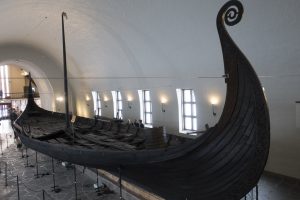Many scholars believe that during the Viking Age the Scandinavian raiders and settlers brought into Ireland a new style of warfare, introducing concepts like total war and formation fighting into Ireland, which previously fought in small raids as its form of waging war. However, this theory disregards the large amount of evidence that the Goidels of Ireland were in constant communication with Britain and Continental Europe throughout the earlier periods, and would have evolved the same styles of warfare as those regions to deal with them.
It is easy to show Ireland’s connection to Roman warfare. There is mounting evidence that Rome was active in Ireland, such as the Roman fort in Drumanagh and burials on Lambay Island. Roman literary evidence also suggests military actions taken into Ireland, such as when the poet Juvenal says that Roman arms have been taken “beyond the shores of Ireland” (Satires) or how Marcellanius’s Historiestells us that the Goidels of Ireland were “tribute-paying” to Rome. Both the Irish and the Romans also mention that Irish princes would go to Rome for help to reclaim lands (John Morris, The Age of Arthur).

There are just as many connections between Ireland and Europe after the fall of Rome. Trade routes through the Shannon River were frequented by Gallic and Frankish (Cecil O’Rahilly, Ireland and Wales). Many Irish kings conquer British land, such as Muiretach mac Erca and Fergus Clendar (John Morris, The Age of Arthur) and the kings of Dyfed come from Irish roots (Cecil O’Rahilly, Ireland and Wales).
Not only were the Goidels often involved in Europe and it’s war style well before the coming of the Vikings into Ireland, many of the battle tactics and equipment usually attributed to Viking influence have a much stronger resemblance to those of the earlier Roman and immediate Post-Roman period. Chainmail armor is commonly thought to have been a Viking introductions, is mentioned many pre-Viking Irish battles poems, such as The Chase of Sid nam Ban Finn and the Death of Finn, The Battle of Magh Rath, and The Battle of Cath Crinna. If we include cases of armor in Ireland being used that, while not explicitly called mail, but is described in ways that suggest it, the list grows. The spark-giving armor of The Battle of Gabhra and the “smooth grey glittering corselets” in the Battle of Cumair being prime examples. When chainmail is mentioned by name, it is called “luirech” or “luraig,” which comes from the Latin “lorica,” rather than the Norse word for chainmail armor, “byrnja,” (Brian Gerard, The Early Medieval Goidel), implying that the armor itself was adopted from either the Romans or the pre-viking people of Britain, which Bede says were united through the use of Latin (The Ecclesiastical History of the English People), and not the Norse-speaking Scandinavians.

The helmets of the Goidels are often described as the “four-cornered, ridged [or “crested”] battle-helm”; this style of construction speaks much more to the earlier late-Roman Intersecta type helmet, where four plates are joined together by narrow bands of metal to make a bowled-shape, with a raised crest of metal running from front to back (Stephen Johnson, A Late Roman Helmet from Burgh Castle), rather than the Viking helmets. In the Tain Bo Cualnge, when the hero Cuchulain is using his sling to throw rocks at the enemy army, they raise a “canopy of shields” for protection against missiles, and this tactic also appears in Battle of Magh Muccuimhe and A Tale of Ailill Moshalaum; while the Romans had similar tactics into the end of the Empire (Philip Rance, The Fulcum: The Late Roman and Byzantine Testudo), there doesn’t seem to be any parallel in viking warfare from which this could have come.
There is also reason to believe that the Goidels were used to long campaigns and hard-fought battles rather than quick raids, with evidence from literary texts such as The War of Fergus and Conchobar, which features the assault of multiple castles as well as open battles, and historians believe the battle of Magh Rath in the 7th century may have lasted many days (Ian Adamson, The Battle of Moira).
Evidence in pre-Viking Ireland—archaeological, linguistic, and literary—all speak to Goidelic warfare of the Medieval Period coming not from the Viking period but rather an earlier tradition, drawing from the Romans and immediate post-Roman peoples. This would also place early medieval Ireland as being just as up-to-date and advanced as the other European peoples, rather than the backwoodsy and outdated people that is frequently imagined.